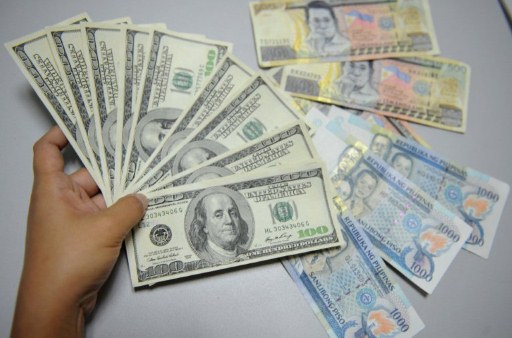
A bank employee displays US dollar (L) and Philippine notes (R) in Manila on August 3, 2011.Philippine President Benigno Aquino said August 3, the US dollar’s weakness could be starting to hurt the Philippines, with domestic inflation a key concern.The Philippine peso has appreciated by about seven percent against the greenback this year, to 42.34 to the dollar on August 3 morning trade. AFP PHOTO / TED ALJIBE
Overseas Filipinos’ remittances grew by 3.2 percent in September, matching August’s growth and marking the second-fastest rate this year.
According to the Bangko Sentral ng Pilipinas (BSP), remittances reached $3.34 billion, up from $3.23 billion in September 2023.
READ: Remittances from OFWs up anew in August
“The expansion in personal remittances in September 2024 was due to higher remittances from land-based workers with work contracts of one year or more and sea- and land-based workers with work contracts of less than one year,” the country’s central bank said in a statement.
The latest posting brought the total amount of remittances from January to September to $28.07 billion, marking a 3-percent growth from the $27.24 billion in the same nine-month period last year.
Main contributors
BSP data also showed that remittances from the United States, Saudi Arabia, Singapore, and the United Arab Emirates were the main contributors during the period.
The United States accounted for the largest share of overall cash remittances during the month, with a 41.3-percent share.
It was followed by Singapore’s 7 percent, Saudi Arabia’ 6.2 percent, Japan’s 4.9 percent, and the United Kingdom’s 4.8 percent.
Of the personal remittances, cash remittances coursed through banks reached $3.01 billion, registering a 3.3-percent increase from the $2.91 billion in September 2023.
The influx of cash remittances during the month brought the year-to-date amount to $25.23 billion, marking a 3-percent growth from the $24.49 billion tallied from January to September 2023.
In a commentary, Rizal Commercial Banking Corp. (RCBC) chief economist Michael Ricafort characterized the continued growth as a “good signal” and a “bright spot” for the country’s overall economy.
Remittances were an important growth driver, especially in terms of consumer spending, which he said accounts for at least 70 percent of the Philippine economy.
“Philippine remittances from overseas workers have consistently been the fourth largest in the world after India, Mexico and China, amounting to more than $40 billion per year, a sign of resilience and has always been a bright spot [and] major growth driver for the Philippine economy for many years,” Ricafort said.